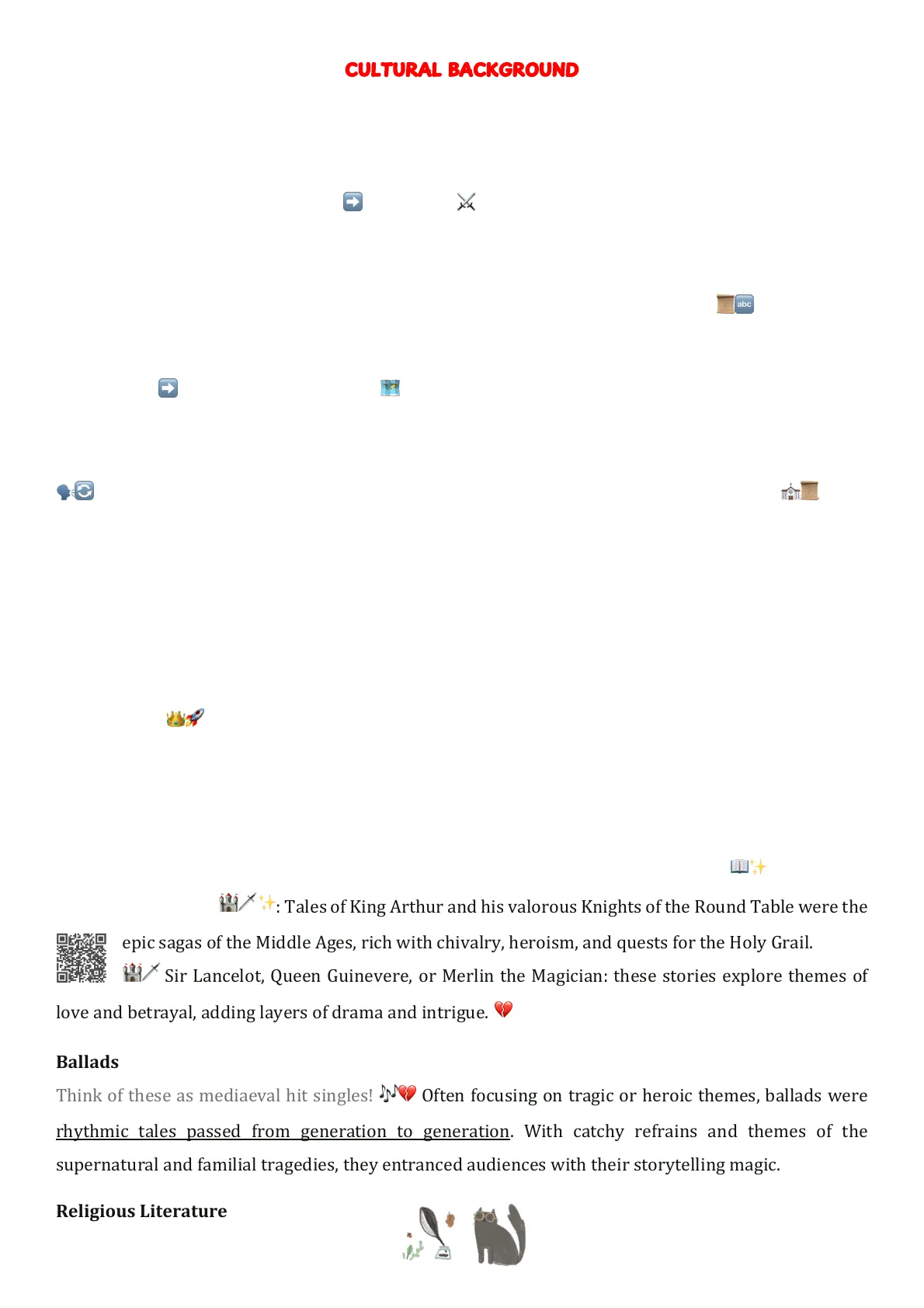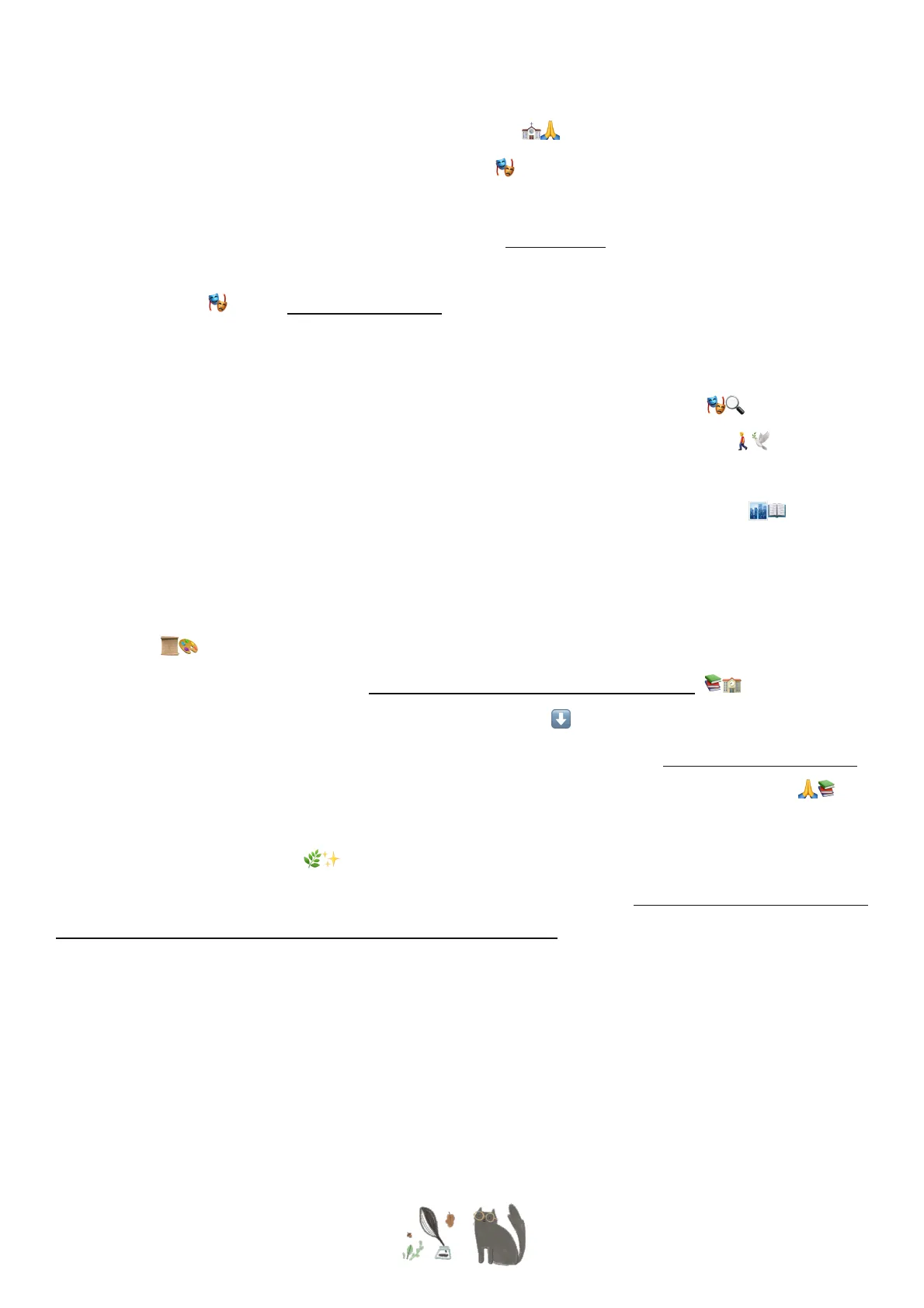Cultural Background: English Medieval Literature and Canterbury Tales
Document from English4teachers about Cultural Background. The Pdf explores English medieval literature, focusing on Old and Middle English periods, epic poetry, and narrative poems. It covers works like 'Beowulf' and 'The Canterbury Tales', analyzing characters, style, and symbols, and includes summaries of specific Canterbury tales for high school Literature students.
See more12 Pages


Unlock the full PDF for free
Sign up to get full access to the document and start transforming it with AI.
Preview
Cultural Background of Medieval English Literature
Mediaeval literature in England refers to the fascinating array of literary works produced during the Middle Ages. This era is divided into two vibrant periods:
- Old English Literature (5th - 11th century)
Highlighted by the epic masterpiece
1
BEOWULF >< Dive into the heroic adventures of Beowulf, a text
that not only serves as a cornerstone of Anglo-Saxon literature but also offers a window into their
culture, beliefs, and values. This period saw the English language dance through significant evolution,
especially after the Norman Conquest in 1066, which added a touch of French flair.
abc - Middle English Literature (12th - 15th century)
Masterpiece
+
CANTERBURY'S TALES
Geoffrey Chaucer's lively tales sketch a vibrant portrait of
mediaeval English society through the voices of its diverse characters. This was a time when stories
were often part of an oral tradition, passed down by word of mouth like treasured secrets.
Dominated by the Catholic Church, this era saw religion heavily influencing literature.
Genres in Medieval Literature
A variety of engaging genres graces the period:
Epic Poetry
Inspired by the greats like the Iliad and the Odyssey, these thrilling poems captured heroic deeds and grand adventures. Think of them as the blockbuster movies of the Middle Ages, shaping ideas of heroism and morality.
Narrative Poems
- These poems spun stories from historical events to imaginative romances, packed with elements like
setting, character, and narration. Whether they offered moral teachings through 'exempla' or explored
the courtly love of knights and maidens, they always aimed to entertain and instruct.
Arthurian Legends
: Tales of King Arthur and his valorous Knights of the Round Table were the epic sagas of the Middle Ages, rich with chivalry, heroism, and quests for the Holy Grail. Sir Lancelot, Queen Guinevere, or Merlin the Magician: these stories explore themes of love and betrayal, adding layers of drama and intrigue.
Ballads
Think of these as mediaeval hit singles! ! Often focusing on tragic or heroic themes, ballads were rhythmic tales passed from generation to generation. With catchy refrains and themes of the supernatural and familial tragedies, they entranced audiences with their storytelling magic.
Religious Literature
8 Copyright @ 2024 English4TeachersThe period's religious texts reflected the era's deep faith and devotion. From Biblical translations to enchanting hymns and chants, these works spread spirituality far and wide, making saints' lives accessible through vibrant tales.
- Adding more drama to the mix were Morality Plays -allegorical performances exploring virtues
and vices; - Miracle Plays depicted miraculous events from saintly lives, offering both instruction and
entertainment to the masses. - Mystery Plays (%, full of biblical storytelling, brought to life in public spaces with impressive sets
and costumes. They became a staple of mediaeval civic life, offering both education and
entertainment.
Let's not forget the cultural tapestry woven by factors like allegory and symbolism or the spiritual journeys embodied in pilgrimages, as beautifully depicted in "The Canterbury Tales." , The cultural pulse of the time was also influenced by the Black Death, which sowed themes of mortality and existential reflection into the literature. As towns rose and urban culture blossomed literature began reflecting the lives of merchants and townsfolk, bridging the gap between the sacred and the secular. Amidst it all, beautifully crafted illuminated manuscripts preserved these treasures for future generations. Literature of the Middle Ages was anything but static, constantly evolving with the times as universities expanded and the Church influenced education and literacy.
Bede Venerable: Father of English History
Bede Venerable (673-735) was a Benedictine monk widely considered the "father of English history." Born in Northumbria, England, he dedicated his life to scholarship and religious devotion. LE His insatiable thirst for knowledge led him to become a renowned teacher and scholar, focusing on theology, grammar, and Latin. Bede is best known for his Historia Ecclesiastica Gentis Anglorum (Ecclesiastical History of the English People), a monumental work that documents the history of the Christian church in England from its beginnings to his time. This work showcases his meticulous research and practical methodology, making it essential for understanding early Christianity in England and its broader European influence. 9 Copyright @ 2024 English4Teachers
Main Authors and Works
Beowulf Epic Poem
Written in Old English, Beowulf is the crown jewel of English epic poetry, being the oldest surviving epic in the English language. Composed around the year 700 AD, this legendary narrative spins tales of a glorious past, highlighting the valiant deeds of its heroes. Originally untitled, it was named after its heroic figure, Beowulf, in the 19th century. Although interwoven with historical elements, the hero and his adventures are fictional.
Beowulf Origins and Society
Beowulf was likely crafted as an elegy for a king who passed away in the 7th century and evolved through numerous retellings before being inscribed. It vividly depicts a Germanic warrior society where the ties between the king and thanes (warriors) are cemented by mutual provision and service. The thanes pledge to protect their leader's realm, and are rewarded with treasures like weapons, armour, gold, and lavish feasts. This world is governed by fate and destiny, deeply rooted in kinship.
Beowulf Plot Summary
A fearsome monster named Grendel terrorises the Danes, launching nightly attacks that leave them helpless for twelve years. Enter Beowulf, a young, bold warrior from Geatland, who sails to Denmark with his men, driven by the resolve to defeat Grendel. During a fierce nocturnal assault, Beowulf confronts and slays Grendel with sheer might. However, the saga doesn't end there. Grendel's vengeful mother, residing in a desolate lake, seeks to avenge her offspring, killing Aeschere, King Hrothgar's trusted advisor. Beowulf plunges into the murky depths to settle the score, slaying her with a giant- forged sword. He decapitates Grendel's remains, presenting the grisly trophy to King Hrothgar. . Upon returning to Geatland, Beowulf ascends to kingship and rules for 50 years, ushering in an era of prosperity. Yet in his twilight years, trouble brews when a thief disturbs a dragon's lair, igniting its fury. This leads to a fiery showdown between Beowulf and the dragon. With the help of the loyal Wiglaf, Beowulf slays the beast but suffers a fatal wound. Honouring his last wishes, Beowulf's warriors cremate his body on a grand pyre and entomb him in a barrow by the sea, a testament to his enduring legacy.
Beowulf Themes
- Warrior Code: Loyalty to a generous and hospitable king guarded by his thanes.
- Vengeance: The ever-present need for retribution.
- Strength and Courage: Valor and strength are paramount virtues.
- Glory: A quest for renown and glory that defines one's life.
10
Copyright @ 2024 English4Teachers
Beowulf Main Features
- Alliterative Style: The poem's rhythmic pattern is defined by alliteration.
- Kenning-Rich: Instead of similes, it's embellished with kennings-metaphorical circumlocutions
like "whale-road" for the sea. - Solemn Tone: The narrative is steeped in a serious and dignified tone, reflecting the gravity of its
themes. J.
Beowulf Text Analysis - Extract
Text Analysis - Extract Taken from Beowulf (Translation by Seamus Heaney) "He grabbed and mauled a man on his bench, Bit into his bone-lappings, bolted down his blood and gorged on him in lumps, leaving the body utterly lifeless, eaten up hand and foot. Venturing closer, his talon was raised to attack Beowulf where he lay on the bed, he was bearing in with open claw when the alert hero's" "Afferrò e straziò un uomo sulla sua panca, Mordé le sue giunture ossee, ingoiò il suo sangue e lo divorò a bocconi, lasciando il corpo completamente privo di vita, divorato mani e piedi. Avvicinandosi, il suo artiglio si alzò per attaccare Beowulf dove giaceva sul letto, stava avanzando con la zampa aperta quando l'eroe vigile" This excerpt paints a vivid and disturbing picture of Grendel's actions, the monster terrorising Denmark. The choice of words and imagery creates a strong, unsettling impression of the monster:
- Brutality: The verbs "grabbed," "mauled," "Bit into," "bolted down," and "gorged" describe a violent
and merciless attack. - Grisly Detail: "Bone-lappings" (giunture delle ossa) and "eaten up hand and foot" emphasise
Grendel's viciousness and brutality. - Contrast: The passage highlights the contrast between Grendel, the monster, and Beowulf, the hero.
Grendel's actions are described with brutal terms, while Beowulf is presented as a vigilant and ready
hero.
. Personification of Evil: The phrase "The captain of evil discovered himself" highlights Grendel's
purely evil nature and his intention to destroy good.
11
Copyright @ 2024 English4Teachers
The Canterbury Tales Overview
The Canterbury Tales is not just the greatest example of a narrative poem in mediaeval literature; it is a foundational work that shaped the course of English literary tradition. Written by Geoffrey Chaucer, often hailed as the "Father of English Poetry," this collection of stories offers a vivid and realistic portrayal of mediaeval society. Through its diverse cast of characters, the poem explores universal human experiences, making it a timeless piece of literature.
The Canterbury Tales Plot
The Canterbury Tales plot is deceptively simple, yet it serves as a powerful framework for exploring a wide range of themes and human behaviours. It is spring, a season symbolising rebirth and renewal, when 30 people, including Chaucer himself as a character, embark on a pilgrimage to the shrine of Saint Thomas Becket in Canterbury. This pilgrimage, a common religious practice in mediaeval England, becomes a microcosm of society, bringing together individuals from different walks of life. The pilgrims gather at the Tabard Inn in London, where the inn's host, Harry Bailey, proposes a storytelling contest to pass the time during their journey. Each pilgrim is to tell two stories on the way to Canterbury and two on the return trip, with a prize awarded to the best storyteller-a meal at the Tabard Inn, paid for by the other pilgrims. This narrative device provides structure to the poem and creates a space for a rich tapestry of voices, each revealing the time's values, concerns, and humour.
The Canterbury Tales Symbols
In The Canterbury Tales, Chaucer uses various symbols to deepen the meaning of the work. Canterbury itself symbolises the celestial city , a metaphor for the ultimate spiritual destination or the afterlife. The pilgrimage ". thus serves as an allegory for the human journey through life, with its trials, temptations, and moments of grace. The season of spring , with its connotations of renewal and new beginnings, contrasts with the idea of pilgrimage, which often signifies penance and reflection. This tension between the earthly and the spiritual +f, the temporal and the eternal, runs throughout the work, inviting readers to consider the complex interplay between body and soul, sin and redemption. Furthermore, the storytelling contest can be seen as a reflection of the diverse and often conflicting values within mediaeval society. The ranging from chivalric romances to bawdy tales , reflect the varied nature of human experience and the different ways people make sense of the world. 12 Copyright @ 2024 English4Teachers